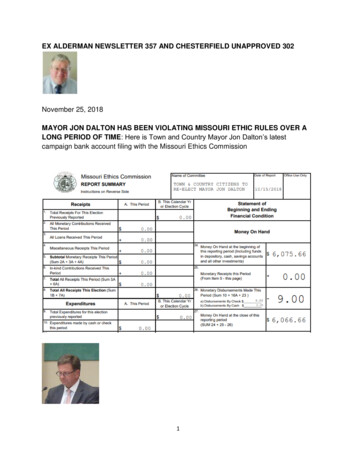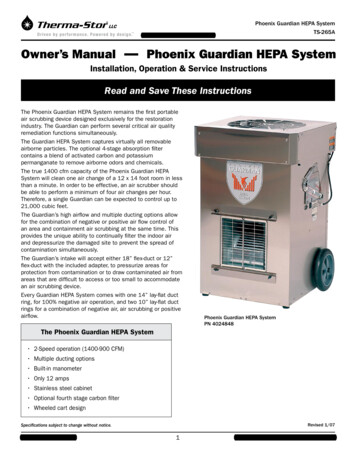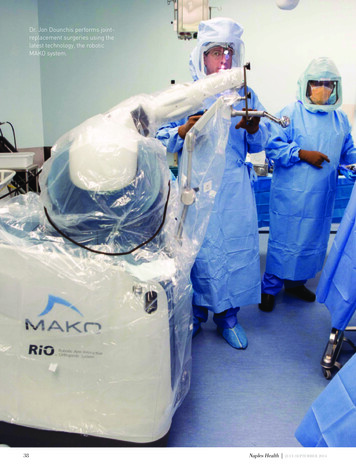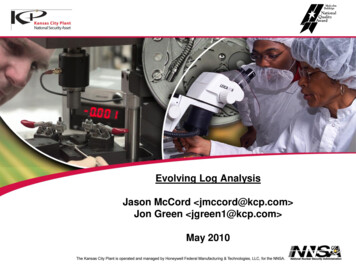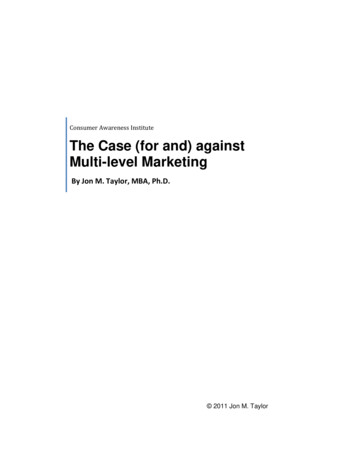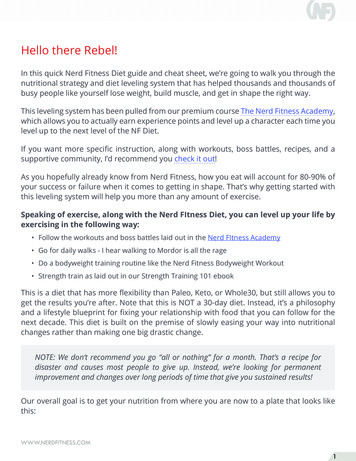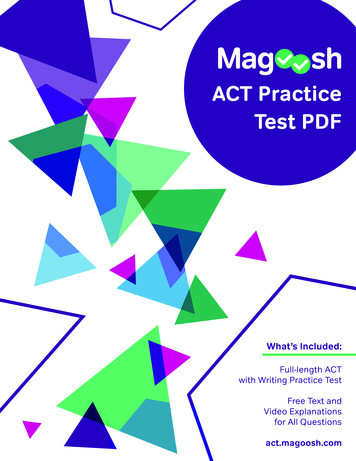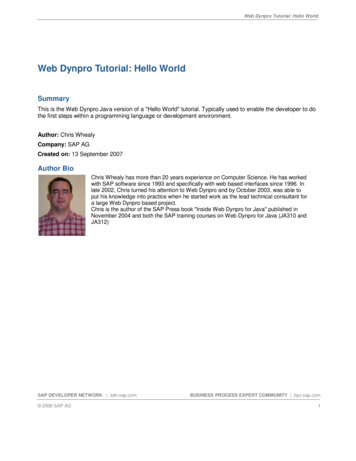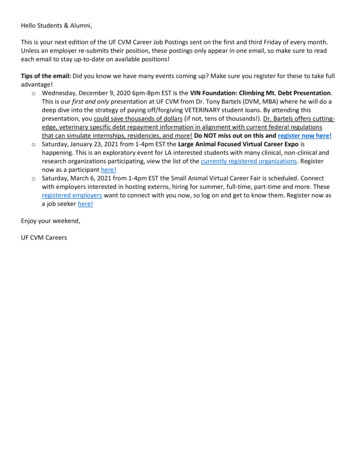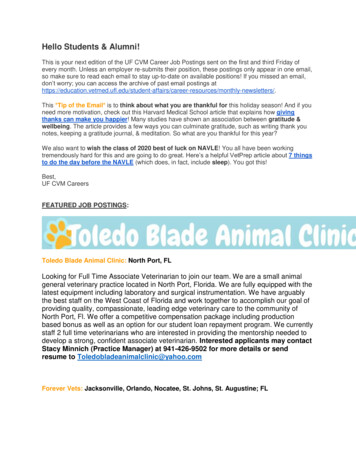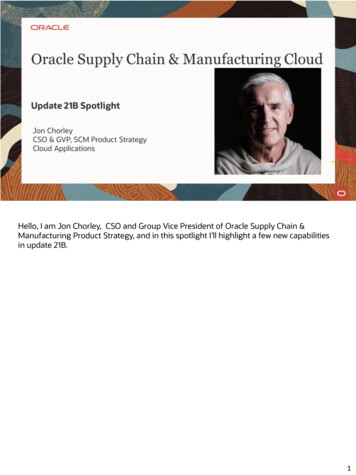
Transcription
Hello, I am Jon Chorley, CSO and Group Vice President of Oracle Supply Chain &Manufacturing Product Strategy, and in this spotlight I’ll highlight a few new capabilitiesin update 21B.1
We will view this Update in the following areas.2
First up, Supply Chain Planning3
Supply Chain Planning Cloud 21B features make it easier to analyze supply chain plansoffline using either Excel or analytics tools such as Oracle Analytics cloud.The existing capability to export plan data to excel for offline edits has been enhancedto be able to import the data after making your edits back into supply chain planningcloud. This enables you to effectively work offline in Excel.In addition, a new data extraction capability synchronizes planning measures in bulk foroffline analysis in your BI and reporting tools. The data synchronization process usesthe built-in BI Cloud Connector (BICC) for seamless integration with Oracle AnalyticsCloud, which you can schedule at regular intervals.4
Next up Inventory5
This feature leverages any received ASN or ASBN from your supplier that contains lotand serial information, to simplify the receiving process. The warehouse operator canview and select the lot and serial numbers assigned when the ASN or ASBN is createdduring the receiving process – eliminating the need to manually reenter the numbers.6
In Oracle Integration Cloud (OIC), you can now subscribe to the new Pick Confirm publicbusiness event to trigger additional business processes or integrate with third-partyapplications. For example, after the Pick Confirm business event is raised, you can usethe Completed Transactions in Inventory REST resource to obtain additional detailsrelated to the completed inventory transaction. Then you can use that information totrigger an external print vendor to print shipping labels for you.7
On to Manufacturing8
Certain Food and Beverage companies want to specify production requirements in dualunits of measure, such as cases for stocking and pounds for valuation purposes. In 21A,we introduced dual units of measure during manufacturing work order transactions.With this release, you can create process manufacturing work definitions and workorders using whichever UOM is most familiar to you. For example, entering productrequirements in cases shows the equivalent pounds, which is calculated based on thestandard or item-specific UOM conversion. It also makes it easier to verify the accuracyof material quantities and understand production execution and reporting in dualUOMs.9
With this feature, you can preassign one or more lot numbers for a product in amanufacturing work order. You have the option to default the work order number asthe lot number during work order creation, or enter a lot or generate a lot after the workorder is created. During product completion, you will be required to use one of thepreassigned lots when putting product into inventory, and will have the ability to updatethe lot origination date, hold until date and expiration date at product completion.Preassigning of the product lots to a work order can help accurately track product lots,their transaction history, and genealogy relationships throughout the productionprocess.10
Now Maintenance11
Work Request was introduced with Limited Availability in 21A and is now GenerallyAvailable in 21B. Work Requests for an installed base asset are supported in the OracleMaintenance Cloud by using the Oracle Help Desk offering. The Help Desk will supportwork requests only for internally owned assets using Internal Service Requests.Work Requests are typically used to report facility and asset related maintenancediscrepancies. They will contain information about the nature of the discrepancy, asset(if known), and a description of the problem. Work Requests are triaged and thenassigned for resolution using maintenance work orders. Once resolved, the originalrequester is updated on the outcome of the Work Request, providing the feedbackloop.12
Now Order Management13
To improve the user experience and efficiency of the sales entry process, you may nowset a time limit from 5 seconds to 240 seconds for the order submit process tocomplete. If it does not complete in this time, it will return the screen back to the userwho may progress to their next task, and the sales order submit process will continue inthe background.14
If you use credit cards to make payment in your upstream source system, then whenyou import orders using the REST API, you may now include the credit card tokens.These are part of the Payment Card Industry Data Security Standard (PCI DSS)requirements and helps to shield sensitive details when you pay for the sales ordertransaction.15
You can now check availability and schedule orders for back-to-back items using realtime supply data from Oracle Cloud Supply Chain Execution. If the item is availableonhand, it will be shipped from stock; otherwise, global order promising will trigger anew purchase order or transfer order to fulfill the demand. Any changes in supply,shipment and delivery dates will be reflected in the sales order line throughout itslifecycle.With this change, you no longer need to collect supply data to update availability forback-to-back purchases or transfers. All other order promising requests continue torely on collected data.16
Next Procurement17
Some of the new capabilities are: One time address in requisition preferences, mastercontract variables in your purchase order terms, specifying a purchase order senderemail address, and line level bid decrements. These are covered in more detail in theProcurement Cloud Update 21B Spotlight delivered by Tom Anthony.18
Now on to Logistics. The main focus for 21B Logistics is migration to OCI. This is aninternal infrastructure project and so we’ll not cover it here.19
Next up PLM including Quality Mgt20
PLM supports the ability to View Context-Specific Attributes in Affected Objects Table.This helps facilitate decision making. Information is also available in the Supplier Portal.21
Item rules now support a function to call global functions, which can call the desiredapplication composer function and returns a value. Thereturned value can be used for assignment or validation. This increases your ability toenforce validations across base and custom objects22
Quality Mgt has introduced Object Hyperlinks to View Related Objects. These providequick, seamless navigation between out of the box Oracle Quality Management objectsand any Application Composer custom object enabled processes.23
Finally, Lets look at IOT applications and Blockchain with Intelligent Track & Trace24
Both Oracle IoT Asset Monitoring and Oracle Production Monitoring now supportFlexible Computation Schedules and improved testing capabilities where you can testMetric values before deployment25
Both Oracle IoT Asset Monitoring and Oracle Production Monitoring now supportFlexible Computation Schedules and improved testing capabilities where you can testMetric values before deployment26
Oracle IoT Fleet Monitoring now applies feature-based machine learning on data fromOracle Transportation Management Cloud (OTM) to determine insights and transit timepredictions for planned shipments – yielding significant improvements in accuracy andcost savings.In addition, a driver (including a third-party carrier driver) can now use the Oracle IoTFleet Monitoring Mobile app to complete a shipment and provide the status of theshipment delivery.27
IOT Connected worker can now add Asset Associations and Locations for a Project fromAsset Monitoring for projects --- and now also supports Wi-Fi based positioning forimproved accuracy where GPS signal is poor or absent.28
Oracle Intelligent Track & Trace with Blockchain now supports Serial Controlled and LotControlled Product Tracking enabling you to support comprehensive backward orforward trace for any given product.29
My name in Jon Chorley, and thank you for watching.30
31
With this release, you can create process manufacturing work definitions and work orders using whichever UOM is most familiar to you. For example, entering product requirements in cases shows the equivalent pounds, which is calculated based on the standard or item-specific UOM conversion. It also makes it easier to verify the accuracy of material quantities and understand production execution .
